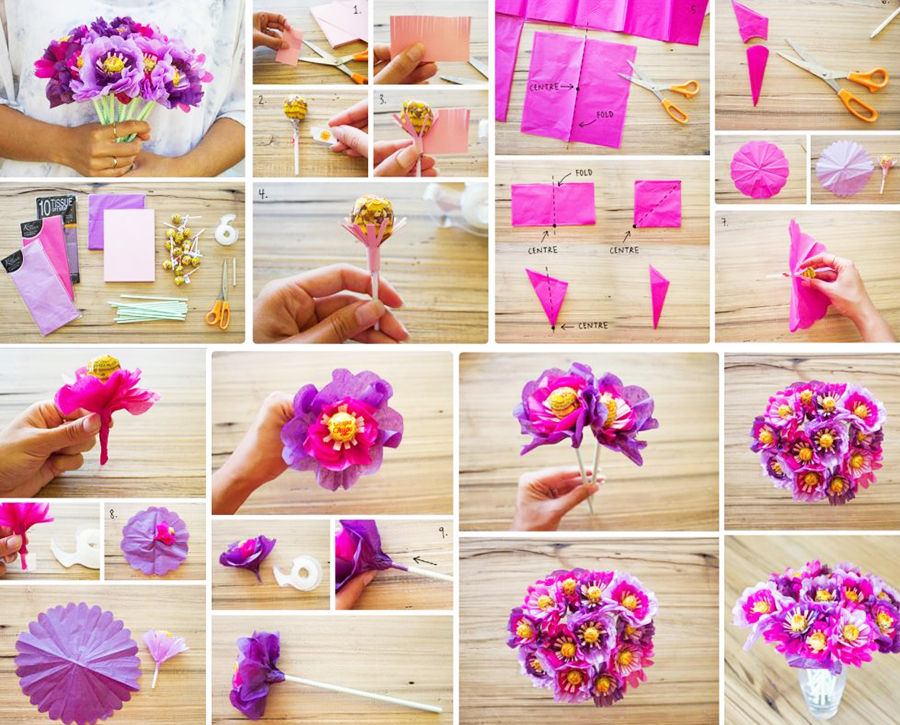During renovation before starting finishing works prepares the base. A correctly selected primer for walls under the wallpaper helps to form a high-quality decorative coating. It will not only look spectacular, but will remain on the surface of the base for a long time. For priming, it is permissible to use various compounds. We propose to deal with the existing varieties and their distinctive features.
Read in the article
- 1 Is it necessary to prime the walls before gluing the wallpaper: important points
- 2 What primer can be used before gluing wallpaper: main varieties
- 2.1 Acrylic and alkyd compounds
- 2.2 Latex and mineral primer
- 2.3 Glyphthalic and perchlorovinyl primer
- 2.4 Universal primer
- 2.5 Priming with wallpaper glue
- 3 What is the best primer for wallpaper walls: important tips
- 4 Wallpaper primer: basic steps
- 4.1 Preparing walls for a primer before gluing wallpaper
- 4.2 How to properly primer walls of different materials before wallpapering
- 4.2.1 Priming concrete walls before wallpapering
- 4.2.2 Is it necessary and how to prime drywall before wallpapering
- 4.2.3 Oil paint
- 4.2.4 Plaster
- 4.2.5 Wood and metal
- 5 How long after applying the primer can the wallpaper be glued
- 6 How much is a primer for walls under wallpaper - price overview
Is it necessary to prime the walls before gluing the wallpaper: important points
In an effort to reduce the cost of finishing work, everyone must make a conclusion on their own. However, it should be noted that the primer:
- makes the wall dry and even, contributes to a more reliable adhesion of the adhesive and the base. The decorative coating stays on the wall longer. A properly formed layer does not crack, preventing moisture penetration into the wall. White primer under wallpaper will not be visible under a thin decorative coating based on a dark color;
- allows the base to "breathe", forming the required microclimate in the room. Thanks to this, it is possible to prevent the spread of the fungus;
- strengthens the wall, using the appropriate compounds, penetrating the pores and filling all defects on the surface.

What primer can be used before gluing wallpaper: main varieties
To decide which primer to use before wallpapering, it is worth getting to know the existing varieties and their distinctive features. This will allow you to select the appropriate composition depending on the type of foundation and the objectives pursued. For a dark surface, choose a pigmented primer under the wallpaper, which allows you to form a light coating.

Acrylic and alkyd compounds
Acrylics are widespread and versatile compounds. A styrene-acrylate dispersion is used as a basis for manufacturing. Can be applied on brick, wood, concrete substrates, plywood, plaster, drywall.
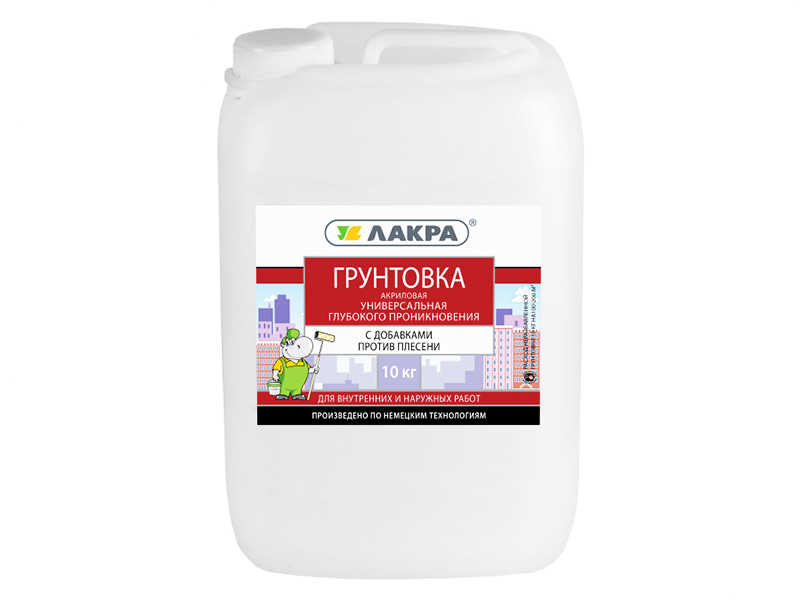
Attention! For ferrous metal, it is better to choose a different composition.
Acrylic wallpaper primer is almost odorless. It takes 2 to 4 hours to dry. Penetrates deep enough, but is not resistant to moisture. Sold in the form of a ready-made liquid solution.
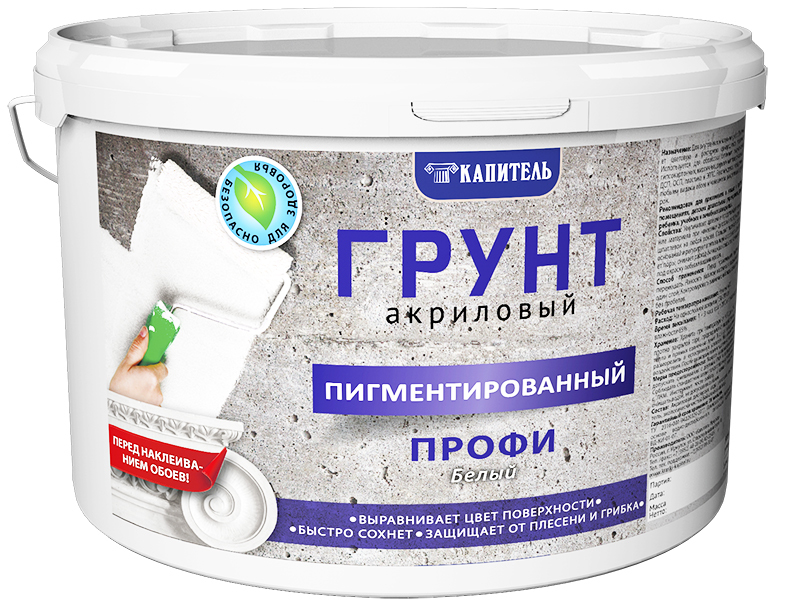
Alkyd is used for processing wood, concrete and reinforced concrete bases. The composition protects the surface from moisture and prevents swelling woodfilling the pores in the top layer. Used to prepare substrates inside and outside the building. Allows you to process the base not only for wallpaper, but also for tiles. Phosphate or zinc chromate is added to the alkyd composition. Select the first type to prepare the base for wallpapering. White primer under the wallpaper will allow you to get a perfectly flat base.
It takes 14-16 hours to dry the formed layer. Has a pungent odor. Compared to other types of compounds, it does not penetrate so well into the material. It is worth refusing to apply this primer to gypsum, drywall and plaster. For dilution, xylene or white spirit is used. Average consumption 100 - 150 g / m².

Latex and mineral primer
The base of the latex primer is synthetic latex. The formed layer is characterized by increased strength, elasticity, and water resistance. Used to prepare loose substrates. The primer can be applied to deteriorating surfaces as well as to highly absorbent materials. A properly formed layer increases the moisture resistance of the base. By adhesion characteristics somewhat inferior to acrylic. Dry quickly. Average consumption 350 - 500 g / m².

A comment
Mikhail Starostin
Head of the team of the repair and construction company "Dom Premium"
“For substrates with poor absorbency or high density, a different primer should be selected.”

For mineral compositions, lime, gypsum or cement acts as a base. They are used for preparation for wallpapering of concrete, gas silicate, expanded clay concrete and bricks. The composition allows you to perfectly level the base, filling the pores on the surface. Almost odorless. Dries quickly. When choosing, you should consider what exactly is used as a basis.

Glyphthalic and perchlorovinyl primer
Glyphthalic is ideal for metal substrates, but also suitable for wood. Allows to form a strong, wear-resistant layer, leveling and increasing the uniformity of the surface. It is not toxic. Before applying a protective composition, the metal is cleaned of rust. It takes 8 to 12 hours to dry.

Perchlorovinyl is applied to a metal, concrete or brick surface. The composition dries quickly. You can start gluing wallpaper half an hour after the completion of the work. Can be applied at low temperatures. Demonstrates good antiseptic and adhesive properties.
Attention! The main disadvantage of perchlorovinyl is its high toxicity. Carrying out work without protective equipment is unacceptable.

Universal primer
The universal ones include acrylate primers, which are based on a mixture of latex and acrylic resins. To impart the required properties, special additives are introduced into their composition. Used when performing work inside and outside the building. It takes 4 - 6 hours to dry. Average consumption 80 - 120 g / m².

Priming with wallpaper glue
If you do not want to purchase a special composition, you should pay attention to wallpaper glue. With its help, you can prepare and strengthen the base, as well as reduce the consumption of adhesive. However, the quality of surface preparation will still be lower than when using a special composition.

Most often, the surface is primed with casein-based glue. However, it is possible to use others. Average consumption is 70 - 100 g / m². It takes about a day to dry.

What is the best primer for wallpaper walls: important tips
It can be difficult to figure out which primer is best for the walls under the wallpaper. In this case, you should use the following important tips:
- for bare surfaces made of foam and gas blocks, limestone, cement, choose a deep penetration primer. Such a composition is able to penetrate to a depth of 15 mm, filling pores and other defects;
- in the absence of special requirements, it is worth choosing a universal composition. When deciding which wall primer to choose for your wallpaper, look at water-based acrylic and latex mixtures. They are cheaper and dry quickly;
- for a wooden base, an alkyd impregnation is suitable. It will hide the resinous knots. Having such a composition on hand, you don't have to think about what kind of primer to treat the walls from OSB, Chipboard, Fiberboard front gluing wallpaper;
- for a brick, concrete base, plaster and foam block, silicate or mineral impregnation is suitable.

Wallpaper primer: basic steps
In order to perform a high-quality priming of the walls before gluing the wallpaper, it is worth getting acquainted with the technology. A quality layer can be formed in several stages. We invite you to get acquainted with the features and content of each.

Preparing walls for a primer before gluing wallpaper
Having decided how to prime the walls before gluing the wallpaper, they prepare the base. The procedure depends on the place of finishing. In a new house, the surface of construction dust should be cleaned, the walls should be leveled with plaster. In the old building:
- remove the old finish;
- control the integrity of the plaster. If necessary, it is completely removed;
- all microcracks are carefully repaired;
- the base is leveled with a sandpaper.

How to properly primer walls of different materials before wallpapering
The sequence of actions for surface preparation directly depends on the type of base. We offer you to figure out how to properly prime the walls before gluing the wallpaper.

Priming concrete walls before wallpapering
The priming of the walls before gluing the wallpaper is performed in the following sequence:
- the base is covered with white spirit or ordinary acetone;
- using a roller, a primer is applied under the wallpaper;
- hard-to-reach places are treated with a brush.

Is it necessary and how to prime drywall before wallpapering
Considering that drywall has a perfectly flat surface, many people think about whether it is necessary to prime it before gluing the wallpaper? Don't even hesitate! This must be done in order to improve the adhesion characteristics. Previously, the joints are filled with a putty or primer, and then the composition is applied to the entire surface.
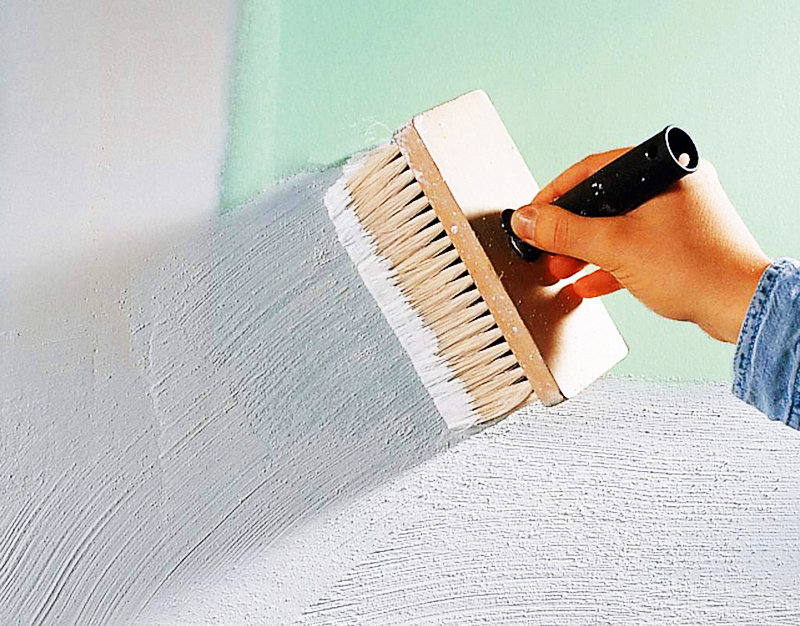
Oil paint
If the base has been painted, it is worth considering whether it is necessary to prime the walls before gluing the wallpaper. This is done without fail. For this, the paintwork is removed by any means at hand, the base is plastered, and then covered with a layer of primer.

Plaster
Before processing the plastered surface, check the integrity of the coating. If there are defects, the layer is removed, and then the base is restored. After making sure of the integrity of the coating, proceed to priming.

Wood and metal
Priming a wooden base performed without fail in order to exclude deformation under the influence of the adhesive composition, as well as to seal the surface. Fresh wood is stripped of resin and sanded. The substrate must be clean and dry.

Whether it is necessary to prime the metal walls before gluing the wallpaper is beyond doubt. With the help of a primer, it is possible to prevent the development of corrosion processes. Before applying the composition, traces of corrosion are removed from the base, and the surface is degreased. Only after that the metal is primed.

We offer you to watch a video, which tells how to properly prime the walls:
How long after applying the primer can the wallpaper be glued
To make the decorative layer even and beautiful, it is worth figuring out when you can glue the wallpaper after priming the walls. Work begins immediately after the coating has dried. When this happens depends on the manufacturer. Usually this information is indicated on the label. However, it should be borne in mind that a number of external factors also affect the drying rate: temperature, humidity level, and the presence of ventilation.
So that you can navigate how long after the primer you can glue the wallpaper, it is worth pointing out that for acrylic compositions with a humidity of 60% and a temperature of 18-25 ° C require 4 - 6 hours, glyphthalic - a day, alkyd - 10 - 16 hours.

How much is a primer for walls under wallpaper - price overview
The price of a primer for walls under wallpaper depends on the manufacturer and the basis of the composition. Average prices are shown in the table:
| Illustration | Brand | Characteristic | Average price (as of the beginning of 2020), rubles |
 | Primer PUFAS TG for wallpaper | Penetrating, waterproof, for all types of substrates. Consumption 0.1 l / m² | 1550 |
| |||
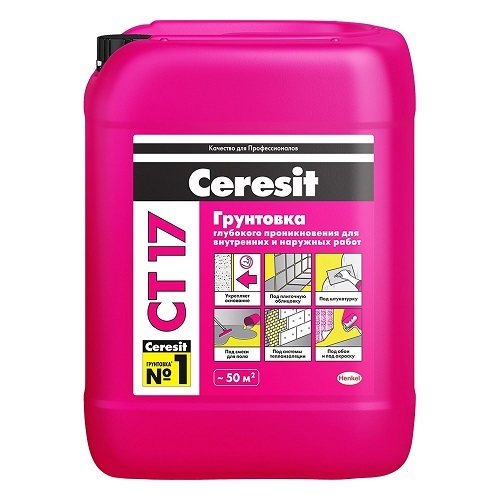 | Deep penetration Ceresit CT 17 primer | Acrylic. Drying within 2 - 4 hours. Consumption 0.1 - 0.2 l / m² | 620 |
| |||
 | NEOMID primer on old paint | Penetrating, frost-resistant. Acrylic. Drying within 1 - 24 hours | 295 |
| |||
 | Primer KNAUF Tiefengrund | Based on polymer dispersion. Apply by roller and brush | 350 |
|
Share in the comments what primer have you used? How satisfied were you with the result?


